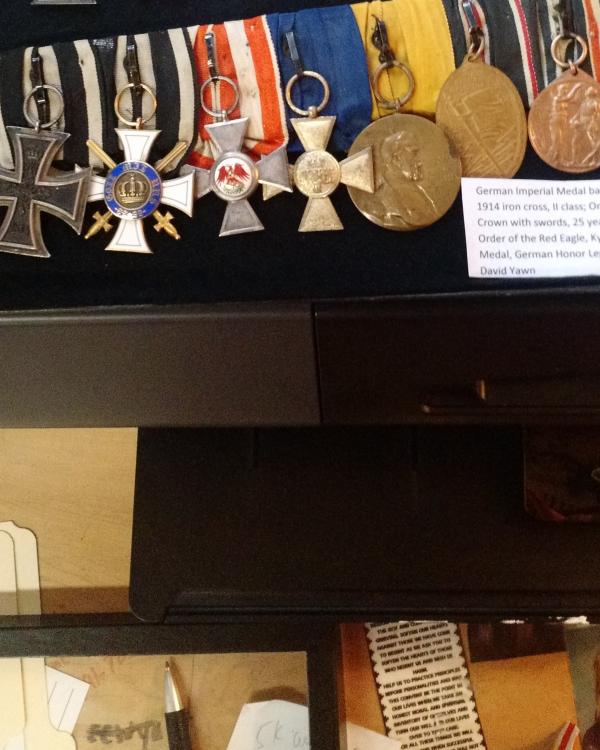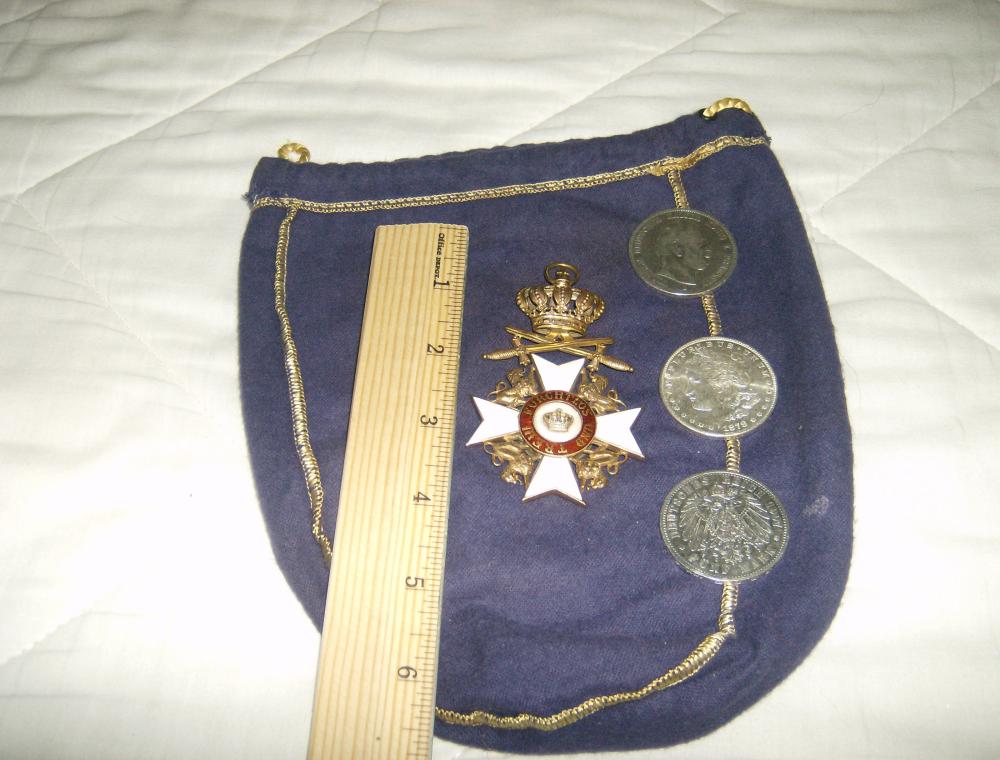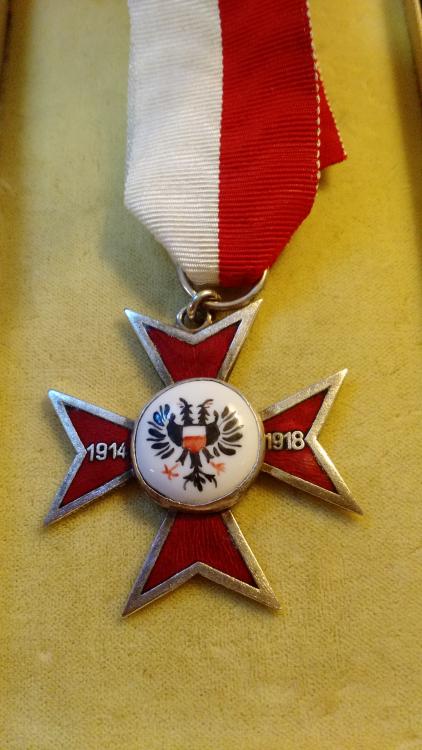-
Posts
132 -
Joined
-
Last visited
Content Type
Profiles
Forums
Blogs
Gallery
Events
Store
Everything posted by eurorders
-
good point. However, I have seen this with other medal bars. On occasion. I did check the backing and it is original, along with a couple of moth holes in the backing wool and a vintage clasp pin. Also the ribbon is worn at the top as would show wear now and then over a century, so I feel fine with it. I posted a few other medal bars I acquired about the same time in another log on this network.
-
Remarking on the other part of your question, here are some good guide books, among others Title Author Year Publisher Orders and Decorations of Europe in Color Hieronymussen 1967 MacMillan British Orders and Decorations Risk 1973 Hayward Orders and Decorations Purves 1972 Hamlyn/Sun Books Ephemeral Decorations Gillingham 1935 Amer Numis Soc. Debrett’s Guide to Heraldry and Regalia Williamson 1992 Headline Orders and Medals of Bulgaria Patrov 2000 Voenno Izdatelstvo Book of Orders of Knighthood and Decorations of Honour of All Nations Burke 1858 N&M Press The History of the Order of Bath and Its Insignia Risk 1972 Spink British Orders, Decorations and Medals Hall 1973 Balfour Court Jewelers of the World Jacob 1978 Postgraduate International Catalogue of Military and Naval Campaign Medals and Gallantry Awards 1980 Sothebys Orders, Decorations, and Insignia, Military and Civil Wyllie 1921 Forgotten Books European Orders and Decorations to 1945 Duckers 2007 Shire British Orders and Decorations Duckers 2004 Shire Bulgaria Imperial Orders and Medals 1887-1945 Furlan 1996 Militaria House Parade Medals of the Third Reich Yanacek 2008 Schiffer Book of Orders and Decorations Mericka 1975 Hamlyn Orders and Decorations Mericka 1967 Hamlyn Orders and Decorations of All Nations Ancient and Modern Civil and Military Werlich Second Edition, 1973 & 1990 Quaker Press Spinks Catalogue of British and Associates Orders, Decorations and Medals Joslin 1983 Webb & Bower Imperial Austrian Medals and Decorations Von Falkenstein 1972 -o- private Militaria: A Study of German Helmets & Uniforms 1729-1918 Kube 1990 Schiffer Orders and Decorations of All Nations Werlich 1965 Quaker Press Military Medals & Decorations of the United States and Europe Ball & Peters 1994 Schiffer Medal Yearbook 2004 Mackay & Mussell 2004 Token Publishing Vernon’s Guide to Orders, Medals & Decoration with Valuations Vernon 2000 Self/private The Medal Collectors’ Companion Collecting and Identifying Orders, Medals and Decorations Vernon 1995 Self/private Royal Insignia: British and Foreign Orders of Chivalry from the Royal Collection Patterson 1997, 1998 The Royal Collection Medals Ribbons of Imperial Austria and Germany Neville 1974 Balfour Publications Militaria – Die Militar Dienstzeichen 1849-1989 Steiner 1993 self Deutsche Orden & Ehrenzeichen 1800 – 1945 Nimmergut 2017 Battenberg Bewertung Katalog Deutschland 1871-1945 Orden Und Ehrenzeichen Niemann 2009 Self/private History of the Early Orders of Knighthood & Chivalry Neville 1978 Albemarle 4 volume Borna Barac series called Reference Catalogue Orders, Medals and Decorations of the World instituted until 1945. Borna Barac 2009 through 2013 OBOL Ribbons and Medals Dorling 1974 Philip British and Foreign Orders, War Medals and Decorations Payne 1981 Hayward
-
That then is one HEAVY medal in gold! Here is some of my budding research on scales and weights of some gold Euro orders of old. I only WISH I owned these, but one day...: " Greek Order Redeemer 18K commander 23.8 grams and 45 MM by 95 MM. Order Vasa 60 by 38 MM 16.5 grams Order Vasa knight crosses: 15.6, 16.1, 14.8, 14.3, 17.9, 16.1, 15.8 and 14.2 grams Order polar star knight 14.46 grams Prussia Order Crown 1st class 62 MM by 67 MM 34.5 grams Prussia Order Crown 1st class 60 MM by 65 MM 25.5 grams Prussia Order Crown commander 52 by 52 19.8 grams Monaco Order St. Charles officer or knight. 20.3 grams Monaco grand cross, order of Karl or Carlos 33.5 grams and 54 MM across Hesse Order Philip the magnanimous knight 13.9 (14 g) 35 MM across. Order Orange Nassau knight, 55 MM side to side and weight 33 grams. German, Saxon military order St. Henry 76 MM by 120 MM 103 grams Bavaria Order St. Michael 47 MM by 83 MM 28.6 grams Bavaria merit order 50 by 77 MM (long cross) An early Bavarian merit order without flames or crown 39 MM by 46 MM and 13.1 grams (1800s) Luxembourg Order Oaken Crown officer, 15 grams Netherlands, Orange Nassau Officer 17 grams Stanislas grand cross 60.5 MM (tall) by 55.5 MM across 30.5 grams St. Stanislas commander 48 MM by 52 MM. Others were 56 MM and 49 MM St. Stanislas first class 61 MM by 66 MM Stanislas first class 27.6 grams St. Stansilas 2nd class 55 MM by 43 MM wide. Weight 11 grams asking $1,800 Stanislas 2nd class 19.9 grams St. Stanislas 2nd class 49 MM by 53 MM Stanslas 2nd class 47 MM by 51 MM Stanislas 3rd class 40 MM by 40 MM and 10.4 grams Stanislas 3rd class 10.4 grams St. Stanislas 3rd class 11 grams and 45 MM Stansilas 3rd class. 40 MM Large early Order of Leopold 40 grams! Another one I saw is 45 grams! Order Franz Josef commander 25.5 grams and 20.7 grams Order Franz Josef commander 37 MM by 70 MM Franz Josef knight cross 16.5 grams Sweden Order of the Sword grand cross 81 MM by 58 MM 39.6 grams other O. of Sword grand crosses 29.5 grams and 30.4 grams Order of Sword commanders cross 79 MM by 59 MM and 34.7 grams> others are 28.6, 33.1, 33.4 grams Order Sword knights crosses 16.7, 21.6, 10.8, 9.8, 11.1, 16.8, 19.9, 16.2 and 15.3 grams Sweden Order North Star knights cross 16.1 , 18.6, 15.4, 12.1, 12.7 and 17.8 grams grams Order North Star grand cross, 27.6 grams Order North Star commanders crosses: 24.3, 27.2 grams Order North star commander 55 MM by 80 MM Sweden Order Seraphim 28. Grams Bavarian Military Merit order 39.6 MM by 46 MM and 13.1 grams Legion Honor Napoleon III grand commander 19.44 grams Legion Honor 2nd empire 43 MM officer 19 grams Legion Honor officer third republic 16 grams Order of the Iron Crown 29.5 MM by 54.7 MM knight breast badge 24.7 grams Order Iron Crown knight 19.31 grams O. Iron Crown 90 MM high and 40 MM wide Hungary Order St. Stephen 42 MM by 78 MM 25.3 grams Saxe Ernestine House Order 57 MM across and 89 MM tall. 1.3 ounces Bavarian Order Military Merit, 2nd class 24.5 grams Brunswick Order of Henry the Lion, commander, 32.4 grams Royal Guelphic Order commander 18K 37.7 grams 48 MM by 76 MM Order Dannebrog 40 MM by 77 MM and 40.6 grams Order Dannebrog knights crosses: 14, 14.8, 15.7, 16.3 12.7, 17.3 and 14.6 grams Dannebrog commanders cross 33.8 grams Dannebrog grand cross 48.2 grams and 32.3 grams (75 MM by 38 MM) Duchy of Parma 10.8 grams knight II class asking 43 MM across, Order Carloss III of spain 11.2 grams Order Vladimir 40 MM by 40 MM (14K) 15.8 grams. Order Vladimir 4th class 39 MM tall by 35 MM wide, 7 grams St. Vladimir 4th class 34.6 MM by 38.8 MM Order Vladmir 4th class 34.5 MM and 7.27 grams St. Anne commander 34.7 MM and 7.7 grams Order St. Anna 35 MM and 9 grams O. St. Anna 2nd class 42.5 MM by 49 MM O. St. Anna 2nd class 21.5 grams St. Anna/Anna 44 MM St. Anna 3rd class 36 MM by 40 MM (14K) St. Anna 45 MM by 45 MM Netherlands O. of North Star, knight 43 MM Netherlands Order North Star first class/grand officer 55 MM by 80 MM Zahringer Lion 39 MM A grand cross 84 MM tall by 54 MM wide, 33.5 grams (a little over ounce) Norwegian Order St. Olav 56 MM by 87 MM Germany Order of White Falcon 40 by 60 MM and 13.2 grams Peter Freidrich Ludwig (Louis) knight cross 15.7 grams Order of Red Eagle II class 20.6 grams Order of the Crown III class 10.8 grams Brandenburg Order of St. Johannis grand cross 102 grams Saxon Order of Albrecht/Albert commander cross 31.2 grams and 32.4 grams, another model Saxon Ernestine House Order commander cross 55.6 grams Wurttemberg Friedrichs order commander cross 29.4 grams Order of Leopold grand cross 50.6 grams Order of Leopold commander 45.4 grams and 10.9 grams Order of Leopold commander 45 grams and 91 MM by 57 MM Another Order Leopold commander 41 grams and 90 MM by 56 MM Pre 1887 Order St. Michael and St. George commander (KC) 68.2 grams Order St. Lazarus, Italy grand cross 36.8 grams Order of the Italian crown grand officer 17.6 grams Order of the Italian crown commander, 15.5 grams Order of the Italian crown officer, 9.1 grams Order St. Olaf grand cross 33.1 grams Order St. Olaf commander 36.1 grams Order of Leopold (Austria) knight 19.4 grams
-
You have excellent tastes in the designs of orders. I sometimes wonder that with the beauty and variety of German states' orders that the various German states must have competed with each other in this arena as to who could make the most spectacular order. In this Mid-Southern metropolis where I live only THREE other people seem to collect enameled orders of decoration. And this is a city of one million!
-

Romanian Order of the Star- quick question
eurorders replied to P.F.'s topic in Central & Eastern European States
I positively love the Romanian Order of the Star and have several versions of it. I think it has a most distinctive design with its starburst/sunburst pattern. Here is some research I have done on the passing art of old enameling for the benefit of others (and myself). When done correctly, the Model 1 exhibited exquisite and complicated enameling of a number of colors in intricate detail and finesse. Excerpted and crediting the book on Enamels by the Smithsonian Illustrated Library of Antiques and prepared by the Cooper-Hewitt Museum. Distilled. Enameling is an outstanding example of human skill and is a refined and sophisticated technique. It has been a craft patronized by the wealthy and for discerning collectors. The jewel-like brilliance of its vitreous surface is durable and the colors in which it can be produced range from the bold and vivid to the subtle and pastel. The particular technical problems inherent in the enameling process with its need for successive firings and the fact that colors change during firing at different temperatures make the production of a really fine enameled piece something to be marveled it. Enamellers have rivaled if not surpassed the work of the finest jewelers. Enameling is an unpredictable art and a combination of intuition and science that demands perception as well as skill for a successful conclusion. Enamel is a vitreous glass glaze that is fused to a metal base. The chemical constituents are silica (sand), borates, alkalis (soda and potash), alkalines (lime, magnesia, lead) and oxides of metals for coloring. There are four4 basic types: opaque, opalescent, translucent and transparent. Production methods include: cloisonné, champlevé (raised field), basse-taille (shallow cut), guilloche (engine-turned), Plique a jour, also known as email de plique. There is also filigree and skan enameling as well as en plain (on an open field). Blue enamel is produced by cobalt. Carbonate of copper produces green, manganese produces purple, oxide of gold produces some pinks and reds. The color is affected by the constitution of the molten glass (flux) and by the type or quantity of the oxide. The majority of enamel colors cannot be mixed to give an intermediate shade. Most of them must be prepared with their own specific oxide. The steps, condensed: 1. The article the enamel is applied to is washed and plunged into a diluted acid to etch the surface in order to give a good key (allover roughness) to which the enamel can adhere. The piece is washed again. 2. Raw enamel is pulverized with water until it is reduced to a fine power. The powder is washed multiple times in distilled water. It is dried and sifted through a fine sieve. 3. It is applied to metal either in powdered form mixed with water and gum tragacanth or by brush or palette knife in which case it must first be mixed with a volatile oil such as spike (lavender) oil or oil of sassafras. 4. Several layers are required to form a cover and each must be dried thoroughly then fired before the next is applied. Firing takes place in a kiln or furnace at temperatures between 600 and 850 degrees Centigrade (or 1110 to 1562 Fahrenheit). Intense white heat is essential to achieve the temperature at which enamel will fuse to metal. Firing takes only a few minutes. 5. Rapid cooling would have a detrimental effect, creating a brittle enamel that could easily crack or scale. 6. Different colors are fired at varying temperatures, those that can withstand the greatest heat, such as brown, blue and green, being fired first. There are multiple applications and firings. In the case of painted enamels, up to 20 firings may be needed. Each time an object is fired, great care must be taken to protect already used colors from damage caused by overfiring. Many articles also are coated on both sides. Once the metal is enclosed between two layers of enamel, the combined substances react simultaneously, another difficult task. 7. The enamel is filed down with carborundum until smooth, fired then polished with the finest pumice powder. Excerpted from the book, Enameling for Beginners by Edward Winter. Distilled. Raw materials for opaque white enamels will melt into liquid glass in from three and a half to four hours, smelting at 2,300 degrees F. By changing the proportions of the ingredients, the opacity or transparency, hardness or softness of enamel is determined. These ingredients are: silica, arsenic oxide, potassium carbonate, borax and lead oxide. (Feldspar is also an ingredient). Focused flames are directed onto the enamel to keep it flowing freely. The molten enamel can be poured into tanks of water to break it up into small particles called frit. Lumps of frit can be crushed into powder that will pass through an 80 or 100 mesh sieve. The powder is then shaken through a sieve onto a platform. Enamel is wet ground in a ball mill. A typical mixture for a small size mill would be 100 parts frit, six parts of clear clay, a fourth part of potassium carbonate and 40 cubic centimeters (about a cup) of water. The produces a slip or slush enamel. When grinding is completed, the enamel is dumped, along with the porcelain grinding balls, into a large 200 mesh sieve resting on a basin. The slush enamel is then shaken through the sieve into the basin. Chromel steel tongs and fork can be used for placing enamel pieces in and out of the furnace. Chromel steel trivets, fire-clay stilts and chromel wire screens support enamel pieces for firing. Enamels of unusual shape need specially designed trivets to hold them successfully. Gum tragacanth, a whitish vegetable gum derived from sea plants, is applied in solution form to metal surfaces to bind the dry, sifted enamel upon them before firing. The flakes should be dissolved by boiling in a basin of water. The resultant solution which should have a watery consistency, is applied with a camel’s hair brush. A few drops of alcohol will keep it from fermenting. Vitreous enamel is the producing of the melting together of the correct proportion of materials in a smelter that reaches a temperature of about 2,100 degrees F. A complete book could be written about the science of producing colors and the great assortment of subtle tones and shades which are crafted. With most manufacturers, these formulae are guarded secrets and handed down. Color is given to the glass enamels by the addition of certain metallic oxides before the raw material batch is smelted and during this melting process the colored enamel is made. Liquid slush or enamel slip colors are processed differently, since colorants and oxides are added to the clear enamel frit by the manufacturer and ground up with the addition of prescribed proportions of water, fine clay and chemical salts in the porcelain ball mill. Enamels for steel, copper and silver are similar in so far as firing temperature is concerned, fusing after two to three minutes at 1,450 to 1,500 degrees F. Excerpted from the book, Metalwork & Enameling by Herbert Maryon. Distilled. Enamel should not be exposed to the direct blast of the flame or it may be discolored. The method is dangerous for firing small silver articles, they melt so easily. Iron scales or rust will discolor clear glass flux or frit, so the enamel must be protected against any accidental flaking of the iron support on which it is fired. All colors must be ground equally find and the heat of furnace needs to reach them all to the same (amount of coverage). In bassetaille enamel, the metal groundplate is chased or sometimes engraved in such a way that its modeled surfaces beneath the enamel form an essential part of the design. Undulating surfaces are visible through the enamel that covers them and take an important share in producing the final effect. If some wet, powdered enamel is to be laid down beside another patch which is still wet, care must be taken that the boundary line between them does not become irregular. The most convenient way to prevent this is to add a little gum tragacanth to each batch of enamel and to allow the first colors to dry before the next are laid alongside them. They will not then spread much on to their neighbor’s territory. In a bassetaille enamel, because so much of its effect depends upon the modeling of the metal beneath it, the enamel itself must have a level and well-polished surface. All depressions in the enameled surface should be filled up and refired and the surface ground level and polished. Any soldered joints must be protected by painting them with rouge or whiting. For more elaborate work, it is sometimes necessary to provide a support made from plaster of Paris. The plaster is made to envelop large portions of the work, leaving exposed only those parts on which the enamel is to come. When all the soldering and cleaning up has been finished and the work is ready for the enameling, it is set up on an iron furnace plate. Plaster of Paris is mixed in a spoon and spread over the work with a spatula. Every part may be covered with plaster except those surfaces which are to be enameled. The work may be fired again and again if necessary, but at no time must a soldered joint be left unprotected. -

Sweden SWEDEN ORDER OF THE SWORD - OLD MODEL
eurorders replied to Graf's topic in Northern European & Baltic States
Hi, since the subject of enamel with orders is so important and because it is the focal point of this thread, I thought it beneficial to share some of my more recent research on this art whose original skill sets are passing with the wind. Excerpted and crediting the book on Enamels by the Smithsonian Illustrated Library of Antiques and prepared by the Cooper-Hewitt Museum. Distilled. Enameling is an outstanding example of human skill and is a refined and sophisticated technique. It has been a craft patronized by the wealthy and for discerning collectors. The jewel-like brilliance of its vitreous surface is durable and the colors in which it can be produced range from the bold and vivid to the subtle and pastel. The particular technical problems inherent in the enameling process with its need for successive firings and the fact that colors change during firing at different temperatures make the production of a really fine enameled piece something to be marveled it. Enamellers have rivaled if not surpassed the work of the finest jewelers. Enameling is an unpredictable art and a combination of intuition and science that demands perception as well as skill for a successful conclusion. Enamel is a vitreous glass glaze that is fused to a metal base. The chemical constituents are silica (sand), borates, alkalis (soda and potash), alkalines (lime, magnesia, lead) and oxides of metals for coloring. There are four4 basic types: opaque, opalescent, translucent and transparent. Production methods include: cloisonné, champlevé (raised field), basse-taille (shallow cut), guilloche (engine-turned), Plique a jour, also known as email de plique. There is also filigree and skan enameling as well as en plain (on an open field). Blue enamel is produced by cobalt. Carbonate of copper produces green, manganese produces purple, oxide of gold produces some pinks and reds. The color is affected by the constitution of the molten glass (flux) and by the type or quantity of the oxide. The majority of enamel colors cannot be mixed to give an intermediate shade. Most of them must be prepared with their own specific oxide. The steps, condensed: 1. The article the enamel is applied to is washed and plunged into a diluted acid to etch the surface in order to give a good key (allover roughness) to which the enamel can adhere. The piece is washed again. 2. Raw enamel is pulverized with water until it is reduced to a fine power. The powder is washed multiple times in distilled water. It is dried and sifted through a fine sieve. 3. It is applied to metal either in powdered form mixed with water and gum tragacanth or by brush or palette knife in which case it must first be mixed with a volatile oil such as spike (lavender) oil or oil of sassafras. 4. Several layers are required to form a cover and each must be dried thoroughly then fired before the next is applied. Firing takes place in a kiln or furnace at temperatures between 600 and 850 degrees Centigrade (or 1110 to 1562 Fahrenheit). Intense white heat is essential to achieve the temperature at which enamel will fuse to metal. Firing takes only a few minutes. 5. Rapid cooling would have a detrimental effect, creating a brittle enamel that could easily crack or scale. 6. Different colors are fired at varying temperatures, those that can withstand the greatest heat, such as brown, blue and green, being fired first. There are multiple applications and firings. In the case of painted enamels, up to 20 firings may be needed. Each time an object is fired, great care must be taken to protect already used colors from damage caused by overfiring. Many articles also are coated on both sides. Once the metal is enclosed between two layers of enamel, the combined substances react simultaneously, another difficult task. 7. The enamel is filed down with carborundum until smooth, fired then polished with the finest pumice powder. Excerpted from the book, Enameling for Beginners by Edward Winter. Distilled. Raw materials for opaque white enamels will melt into liquid glass in from three and a half to four hours, smelting at 2,300 degrees F. By changing the proportions of the ingredients, the opacity or transparency, hardness or softness of enamel is determined. These ingredients are: silica, arsenic oxide, potassium carbonate, borax and lead oxide. (Feldspar is also an ingredient). Focused flames are directed onto the enamel to keep it flowing freely. The molten enamel can be poured into tanks of water to break it up into small particles called frit. Lumps of frit can be crushed into powder that will pass through an 80 or 100 mesh sieve. The powder is then shaken through a sieve onto a platform. Enamel is wet ground in a ball mill. A typical mixture for a small size mill would be 100 parts frit, six parts of clear clay, a fourth part of potassium carbonate and 40 cubic centimeters (about a cup) of water. The produces a slip or slush enamel. When grinding is completed, the enamel is dumped, along with the porcelain grinding balls, into a large 200 mesh sieve resting on a basin. The slush enamel is then shaken through the sieve into the basin. Chromel steel tongs and fork can be used for placing enamel pieces in and out of the furnace. Chromel steel trivets, fire-clay stilts and chromel wire screens support enamel pieces for firing. Enamels of unusual shape need specially designed trivets to hold them successfully. Gum tragacanth, a whitish vegetable gum derived from sea plants, is applied in solution form to metal surfaces to bind the dry, sifted enamel upon them before firing. The flakes should be dissolved by boiling in a basin of water. The resultant solution which should have a watery consistency, is applied with a camel’s hair brush. A few drops of alcohol will keep it from fermenting. Vitreous enamel is the producing of the melting together of the correct proportion of materials in a smelter that reaches a temperature of about 2,100 degrees F. A complete book could be written about the science of producing colors and the great assortment of subtle tones and shades which are crafted. With most manufacturers, these formulae are guarded secrets and handed down. Color is given to the glass enamels by the addition of certain metallic oxides before the raw material batch is smelted and during this melting process the colored enamel is made. Liquid slush or enamel slip colors are processed differently, since colorants and oxides are added to the clear enamel frit by the manufacturer and ground up with the addition of prescribed proportions of water, fine clay and chemical salts in the porcelain ball mill. Enamels for steel, copper and silver are similar in so far as firing temperature is concerned, fusing after two to three minutes at 1,450 to 1,500 degrees F. Excerpted from the book, Metalwork & Enameling by Herbert Maryon. Distilled. Enamel should not be exposed to the direct blast of the flame or it may be discolored. The method is dangerous for firing small silver articles, they melt so easily. Iron scales or rust will discolor clear glass flux or frit, so the enamel must be protected against any accidental flaking of the iron support on which it is fired. All colors must be ground equally find and the heat of furnace needs to reach them all to the same (amount of coverage). In bassetaille enamel, the metal groundplate is chased or sometimes engraved in such a way that its modeled surfaces beneath the enamel form an essential part of the design. Undulating surfaces are visible through the enamel that covers them and take an important share in producing the final effect. If some wet, powdered enamel is to be laid down beside another patch which is still wet, care must be taken that the boundary line between them does not become irregular. The most convenient way to prevent this is to add a little gum tragacanth to each batch of enamel and to allow the first colors to dry before the next are laid alongside them. They will not then spread much on to their neighbor’s territory. In a bassetaille enamel, because so much of its effect depends upon the modeling of the metal beneath it, the enamel itself must have a level and well-polished surface. All depressions in the enameled surface should be filled up and refired and the surface ground level and polished. Any soldered joints must be protected by painting them with rouge or whiting. For more elaborate work, it is sometimes necessary to provide a support made from plaster of Paris. The plaster is made to envelop large portions of the work, leaving exposed only those parts on which the enamel is to come. When all the soldering and cleaning up has been finished and the work is ready for the enameling, it is set up on an iron furnace plate. Plaster of Paris is mixed in a spoon and spread over the work with a spatula. Every part may be covered with plaster except those surfaces which are to be enameled. The work may be fired again and again if necessary, but at no time must a soldered joint be left unprotected. -

King Ferdinand I's decorations
eurorders replied to ilieff's topic in Central & Eastern European States
I believe that Bulgarian kingdom awards will only grow in popularity over time among phaleristic enthusiasts. I personally love the green commander level of the Order of Alexander in all its iterations. Since the fine and somewhat lost art of enameling is something that all of us order collectors need to delve into further, I am here sharing some of my more recent research for the good of all. Excerpted and crediting the book on Enamels by the Smithsonian Illustrated Library of Antiques and prepared by the Cooper-Hewitt Museum. Distilled. Enameling is an outstanding example of human skill and is a refined and sophisticated technique. It has been a craft patronized by the wealthy and for discerning collectors. The jewel-like brilliance of its vitreous surface is durable and the colors in which it can be produced range from the bold and vivid to the subtle and pastel. The particular technical problems inherent in the enameling process with its need for successive firings and the fact that colors change during firing at different temperatures make the production of a really fine enameled piece something to be marveled it. Enamellers have rivaled if not surpassed the work of the finest jewelers. Enameling is an unpredictable art and a combination of intuition and science that demands perception as well as skill for a successful conclusion. Enamel is a vitreous glass glaze that is fused to a metal base. The chemical constituents are silica (sand), borates, alkalis (soda and potash), alkalines (lime, magnesia, lead) and oxides of metals for coloring. There are four4 basic types: opaque, opalescent, translucent and transparent. Production methods include: cloisonné, champlevé (raised field), basse-taille (shallow cut), guilloche (engine-turned), Plique a jour, also known as email de plique. There is also filigree and skan enameling as well as en plain (on an open field). Blue enamel is produced by cobalt. Carbonate of copper produces green, manganese produces purple, oxide of gold produces some pinks and reds. The color is affected by the constitution of the molten glass (flux) and by the type or quantity of the oxide. The majority of enamel colors cannot be mixed to give an intermediate shade. Most of them must be prepared with their own specific oxide. The steps, condensed: 1. The article the enamel is applied to is washed and plunged into a diluted acid to etch the surface in order to give a good key (allover roughness) to which the enamel can adhere. The piece is washed again. 2. Raw enamel is pulverized with water until it is reduced to a fine power. The powder is washed multiple times in distilled water. It is dried and sifted through a fine sieve. 3. It is applied to metal either in powdered form mixed with water and gum tragacanth or by brush or palette knife in which case it must first be mixed with a volatile oil such as spike (lavender) oil or oil of sassafras. 4. Several layers are required to form a cover and each must be dried thoroughly then fired before the next is applied. Firing takes place in a kiln or furnace at temperatures between 600 and 850 degrees Centigrade (or 1110 to 1562 Fahrenheit). Intense white heat is essential to achieve the temperature at which enamel will fuse to metal. Firing takes only a few minutes. 5. Rapid cooling would have a detrimental effect, creating a brittle enamel that could easily crack or scale. 6. Different colors are fired at varying temperatures, those that can withstand the greatest heat, such as brown, blue and green, being fired first. There are multiple applications and firings. In the case of painted enamels, up to 20 firings may be needed. Each time an object is fired, great care must be taken to protect already used colors from damage caused by overfiring. Many articles also are coated on both sides. Once the metal is enclosed between two layers of enamel, the combined substances react simultaneously, another difficult task. 7. The enamel is filed down with carborundum until smooth, fired then polished with the finest pumice powder. Excerpted from the book, Enameling for Beginners by Edward Winter. Distilled. Raw materials for opaque white enamels will melt into liquid glass in from three and a half to four hours, smelting at 2,300 degrees F. By changing the proportions of the ingredients, the opacity or transparency, hardness or softness of enamel is determined. These ingredients are: silica, arsenic oxide, potassium carbonate, borax and lead oxide. (Feldspar is also an ingredient). Focused flames are directed onto the enamel to keep it flowing freely. The molten enamel can be poured into tanks of water to break it up into small particles called frit. Lumps of frit can be crushed into powder that will pass through an 80 or 100 mesh sieve. The powder is then shaken through a sieve onto a platform. Enamel is wet ground in a ball mill. A typical mixture for a small size mill would be 100 parts frit, six parts of clear clay, a fourth part of potassium carbonate and 40 cubic centimeters (about a cup) of water. The produces a slip or slush enamel. When grinding is completed, the enamel is dumped, along with the porcelain grinding balls, into a large 200 mesh sieve resting on a basin. The slush enamel is then shaken through the sieve into the basin. Chromel steel tongs and fork can be used for placing enamel pieces in and out of the furnace. Chromel steel trivets, fire-clay stilts and chromel wire screens support enamel pieces for firing. Enamels of unusual shape need specially designed trivets to hold them successfully. Gum tragacanth, a whitish vegetable gum derived from sea plants, is applied in solution form to metal surfaces to bind the dry, sifted enamel upon them before firing. The flakes should be dissolved by boiling in a basin of water. The resultant solution which should have a watery consistency, is applied with a camel’s hair brush. A few drops of alcohol will keep it from fermenting. Vitreous enamel is the producing of the melting together of the correct proportion of materials in a smelter that reaches a temperature of about 2,100 degrees F. A complete book could be written about the science of producing colors and the great assortment of subtle tones and shades which are crafted. With most manufacturers, these formulae are guarded secrets and handed down. Color is given to the glass enamels by the addition of certain metallic oxides before the raw material batch is smelted and during this melting process the colored enamel is made. Liquid slush or enamel slip colors are processed differently, since colorants and oxides are added to the clear enamel frit by the manufacturer and ground up with the addition of prescribed proportions of water, fine clay and chemical salts in the porcelain ball mill. Enamels for steel, copper and silver are similar in so far as firing temperature is concerned, fusing after two to three minutes at 1,450 to 1,500 degrees F. Excerpted from the book, Metalwork & Enameling by Herbert Maryon. Distilled. Enamel should not be exposed to the direct blast of the flame or it may be discolored. The method is dangerous for firing small silver articles, they melt so easily. Iron scales or rust will discolor clear glass flux or frit, so the enamel must be protected against any accidental flaking of the iron support on which it is fired. All colors must be ground equally find and the heat of furnace needs to reach them all to the same (amount of coverage). In bassetaille enamel, the metal groundplate is chased or sometimes engraved in such a way that its modeled surfaces beneath the enamel form an essential part of the design. Undulating surfaces are visible through the enamel that covers them and take an important share in producing the final effect. If some wet, powdered enamel is to be laid down beside another patch which is still wet, care must be taken that the boundary line between them does not become irregular. The most convenient way to prevent this is to add a little gum tragacanth to each batch of enamel and to allow the first colors to dry before the next are laid alongside them. They will not then spread much on to their neighbor’s territory. In a bassetaille enamel, because so much of its effect depends upon the modeling of the metal beneath it, the enamel itself must have a level and well-polished surface. All depressions in the enameled surface should be filled up and refired and the surface ground level and polished. Any soldered joints must be protected by painting them with rouge or whiting. For more elaborate work, it is sometimes necessary to provide a support made from plaster of Paris. The plaster is made to envelop large portions of the work, leaving exposed only those parts on which the enamel is to come. When all the soldering and cleaning up has been finished and the work is ready for the enameling, it is set up on an iron furnace plate. Plaster of Paris is mixed in a spoon and spread over the work with a spatula. Every part may be covered with plaster except those surfaces which are to be enameled. The work may be fired again and again if necessary, but at no time must a soldered joint be left unprotected. -

Bulgaria FAKE BULGARIAN ORDERS ON THE MARKET
eurorders replied to Graf's topic in Central & Eastern European States
I, too, am a lover of Bulgarian kingdom orders. As an aside, I have done some research on a side, but important, area related to the manufacture of original orders of decoration, namely, the fine and difficult art of enameling. I thought I would share it for the good of the cause. It makes me appreciate so much the arduous process of making original orders of decoration. Excerpted and crediting the book on Enamels by the Smithsonian Illustrated Library of Antiques and prepared by the Cooper-Hewitt Museum. Distilled. Enameling is an outstanding example of human skill and is a refined and sophisticated technique. It has been a craft patronized by the wealthy and for discerning collectors. The jewel-like brilliance of its vitreous surface is durable and the colors in which it can be produced range from the bold and vivid to the subtle and pastel. The particular technical problems inherent in the enameling process with its need for successive firings and the fact that colors change during firing at different temperatures make the production of a really fine enameled piece something to be marveled it. Enamellers have rivaled if not surpassed the work of the finest jewelers. Enameling is an unpredictable art and a combination of intuition and science that demands perception as well as skill for a successful conclusion. Enamel is a vitreous glass glaze that is fused to a metal base. The chemical constituents are silica (sand), borates, alkalis (soda and potash), alkalines (lime, magnesia, lead) and oxides of metals for coloring. There are four4 basic types: opaque, opalescent, translucent and transparent. Production methods include: cloisonné, champlevé (raised field), basse-taille (shallow cut), guilloche (engine-turned), Plique a jour, also known as email de plique. There is also filigree and skan enameling as well as en plain (on an open field). Blue enamel is produced by cobalt. Carbonate of copper produces green, manganese produces purple, oxide of gold produces some pinks and reds. The color is affected by the constitution of the molten glass (flux) and by the type or quantity of the oxide. The majority of enamel colors cannot be mixed to give an intermediate shade. Most of them must be prepared with their own specific oxide. The steps, condensed: 1. The article the enamel is applied to is washed and plunged into a diluted acid to etch the surface in order to give a good key (allover roughness) to which the enamel can adhere. The piece is washed again. 2. Raw enamel is pulverized with water until it is reduced to a fine power. The powder is washed multiple times in distilled water. It is dried and sifted through a fine sieve. 3. It is applied to metal either in powdered form mixed with water and gum tragacanth or by brush or palette knife in which case it must first be mixed with a volatile oil such as spike (lavender) oil or oil of sassafras. 4. Several layers are required to form a cover and each must be dried thoroughly then fired before the next is applied. Firing takes place in a kiln or furnace at temperatures between 600 and 850 degrees Centigrade (or 1110 to 1562 Fahrenheit). Intense white heat is essential to achieve the temperature at which enamel will fuse to metal. Firing takes only a few minutes. 5. Rapid cooling would have a detrimental effect, creating a brittle enamel that could easily crack or scale. 6. Different colors are fired at varying temperatures, those that can withstand the greatest heat, such as brown, blue and green, being fired first. There are multiple applications and firings. In the case of painted enamels, up to 20 firings may be needed. Each time an object is fired, great care must be taken to protect already used colors from damage caused by overfiring. Many articles also are coated on both sides. Once the metal is enclosed between two layers of enamel, the combined substances react simultaneously, another difficult task. 7. The enamel is filed down with carborundum until smooth, fired then polished with the finest pumice powder. Excerpted from the book, Enameling for Beginners by Edward Winter. Distilled. Raw materials for opaque white enamels will melt into liquid glass in from three and a half to four hours, smelting at 2,300 degrees F. By changing the proportions of the ingredients, the opacity or transparency, hardness or softness of enamel is determined. These ingredients are: silica, arsenic oxide, potassium carbonate, borax and lead oxide. (Feldspar is also an ingredient). Focused flames are directed onto the enamel to keep it flowing freely. The molten enamel can be poured into tanks of water to break it up into small particles called frit. Lumps of frit can be crushed into powder that will pass through an 80 or 100 mesh sieve. The powder is then shaken through a sieve onto a platform. Enamel is wet ground in a ball mill. A typical mixture for a small size mill would be 100 parts frit, six parts of clear clay, a fourth part of potassium carbonate and 40 cubic centimeters (about a cup) of water. The produces a slip or slush enamel. When grinding is completed, the enamel is dumped, along with the porcelain grinding balls, into a large 200 mesh sieve resting on a basin. The slush enamel is then shaken through the sieve into the basin. Chromel steel tongs and fork can be used for placing enamel pieces in and out of the furnace. Chromel steel trivets, fire-clay stilts and chromel wire screens support enamel pieces for firing. Enamels of unusual shape need specially designed trivets to hold them successfully. Gum tragacanth, a whitish vegetable gum derived from sea plants, is applied in solution form to metal surfaces to bind the dry, sifted enamel upon them before firing. The flakes should be dissolved by boiling in a basin of water. The resultant solution which should have a watery consistency, is applied with a camel’s hair brush. A few drops of alcohol will keep it from fermenting. Vitreous enamel is the producing of the melting together of the correct proportion of materials in a smelter that reaches a temperature of about 2,100 degrees F. A complete book could be written about the science of producing colors and the great assortment of subtle tones and shades which are crafted. With most manufacturers, these formulae are guarded secrets and handed down. Color is given to the glass enamels by the addition of certain metallic oxides before the raw material batch is smelted and during this melting process the colored enamel is made. Liquid slush or enamel slip colors are processed differently, since colorants and oxides are added to the clear enamel frit by the manufacturer and ground up with the addition of prescribed proportions of water, fine clay and chemical salts in the porcelain ball mill. Enamels for steel, copper and silver are similar in so far as firing temperature is concerned, fusing after two to three minutes at 1,450 to 1,500 degrees F. Excerpted from the book, Metalwork & Enameling by Herbert Maryon. Distilled. Enamel should not be exposed to the direct blast of the flame or it may be discolored. The method is dangerous for firing small silver articles, they melt so easily. Iron scales or rust will discolor clear glass flux or frit, so the enamel must be protected against any accidental flaking of the iron support on which it is fired. All colors must be ground equally find and the heat of furnace needs to reach them all to the same (amount of coverage). In bassetaille enamel, the metal groundplate is chased or sometimes engraved in such a way that its modeled surfaces beneath the enamel form an essential part of the design. Undulating surfaces are visible through the enamel that covers them and take an important share in producing the final effect. If some wet, powdered enamel is to be laid down beside another patch which is still wet, care must be taken that the boundary line between them does not become irregular. The most convenient way to prevent this is to add a little gum tragacanth to each batch of enamel and to allow the first colors to dry before the next are laid alongside them. They will not then spread much on to their neighbor’s territory. In a bassetaille enamel, because so much of its effect depends upon the modeling of the metal beneath it, the enamel itself must have a level and well-polished surface. All depressions in the enameled surface should be filled up and refired and the surface ground level and polished. Any soldered joints must be protected by painting them with rouge or whiting. For more elaborate work, it is sometimes necessary to provide a support made from plaster of Paris. The plaster is made to envelop large portions of the work, leaving exposed only those parts on which the enamel is to come. When all the soldering and cleaning up has been finished and the work is ready for the enameling, it is set up on an iron furnace plate. Plaster of Paris is mixed in a spoon and spread over the work with a spatula. Every part may be covered with plaster except those surfaces which are to be enameled. The work may be fired again and again if necessary, but at no time must a soldered joint be left unprotected. -
Hi, work has kept me semi busy, but I wanted to attend to your questions of recent. Although I've returned the set to its bank vault, I do have some answers. Yes, The Rose name is in the silk in the upper inside of the case. In regard to the Godet label, it looks to my memory just like the logo pictured in the mid section illustration of Jeffrey Jacob's book "Court Jewelers of the World." For that matter, I wish I could talk with Mr. Jacob and commend him on his 1978 work. Gene Springer wrote the Foreword and Jerome Platt was the editor. I am thinking the order was likely made between about 1911 and 1914, but that is my own guestimate. I did speak with an authority on German orders and he told me that, after seeing the photos, (abridged) "As I can see, parts of the decoration have the typical gold-patina of old gold, as it occurs, as you said, from the slightly different alloy of the parts. This patina also is often to be seen in the centres of Prussian Orders of the Crown centres. This patina is a sign for originality, you absolutely should not “clean” it! Generally spoken: The bright colour of the cross itself may occur by higher fineness of gold, as these crosses were made hollow with thin gold-tin struck and put together. To work them out the gold had to be weaker and therefore of higher fineness. The Griffins, made massive, were made of lower fine gold, in order not to make them too heavy (and also to save gold) and that’s the reason for the gold patina. And the crown was made of lower fine gold for structural reasons, as your colleague said. Also suspension and ribbon rings often are of a lower fineness of gold, in order to make them harder, in order that they don’t break. The ring doesn’t show the gold patina, as it was “cleaned” by wear with the silk ribbon. Such lower gold parts often have been galvanically gilt with pure gold again, in order that the slightly different colours are not be seen. The pictures are exactly demonstrating the constructing and working out of the pieces."
-
Happy to oblige. It took a little while because I had it in the vault. I had to downsize the photos greatly as they were each 5MB and I had to ask for help downsizing them electronically first. As I look at the griffins, they now look to my eye to be gold rather than silver, but I have a red-green color deficiency in my eyes. However, the gold looks to be of a different amalgam than the suspension ring or the connector at the top of the cross arms. when I turn the cross sideways, I see a more vibrant yellow gold like the suspension ring.
-

Order of the Bath help need!
eurorders replied to sturm's topic in Great Britain: Orders, Gallantry, Campaign Medals
Thanks for that research very much. -
First of all, thank you. To answer the more recent question, that order with the swords is gold (appearance, proper weight, W hallmark). I am enclosing a better picture of the medal bar and also the one above it. Please also comment, all of you on the one above it. This is what I was told of the medal bar above it. That one likely was awarded to a Bavarian commissioned officer who was most likely a lieutenant during WWI. He was out of the military after WWI but then recalled to active duty circa 1939 for service in WWII. He was probably promoted to Hauptmann (captain) at the time he was recalled to active service.
-

Order of the Bath help need!
eurorders replied to sturm's topic in Great Britain: Orders, Gallantry, Campaign Medals
Greetings, I am a brand new member of this fine forum. I have an interest in finding out if this officer was truly in the rolls as a recipient of the KC Order of Bath in the year bracket shown. I already have his biography. Thanks -
Hi, I am a new member of the gmic and have been an enthusiastic Euro medals and orders collector for 17 years (when I am not collecting coins). Question: Is this an accurate guess about this medal bar or can it be made more specific or corrected? I know some of this is slight conjecture...thanks This was awarded to a Prussian commissioned officer, probably holding the rank of major or oberstleutnant (lieutenant colonel). This officer presumedly was retired from service sometime during the Weimar period. The presence of the Kyffhauserbund Medal and the Ehrenlegion medal confirm that this bar is of the Weimar period. It is pre-1934 as there is no Hindenburg Cross on the bar. The retired officer was around 60 years old by the mid 1930s.
-
Hi, I recently acquired this cased version of the Mecklenburg Schwerin Order of the Wendish/Wendian Crown. Which is more used - Wendish or Wendian? A Grand Commander set with original ribbon. (thick watered silk ribbon/cordon is very faded on the other side which is another nice sign of vintage age). Interesting that the Griffins are silver, but the bale is gold and the cross arms are gold and the ornate suspension is gold. Its intricate features are hand tooled in the old European style. Back of breast star says Godet in Berlin but the case has on the upper silk the imprint of H. Rose (Schwerin) . Everything fits very very well in the old fitted case. Monogram on top. Griffins very refined and detailed. Decade of manufacture?? The crown might be the ore material mentioned in either Borna Borac's books or Nimmergut book. I do not own the book, Die Mecklenburg-Strelitzer Orden und Ehrenzeichen so I would be interested what is in it about this medal set. I wonder how many were awarded or allowed to be at a given time by the registry.


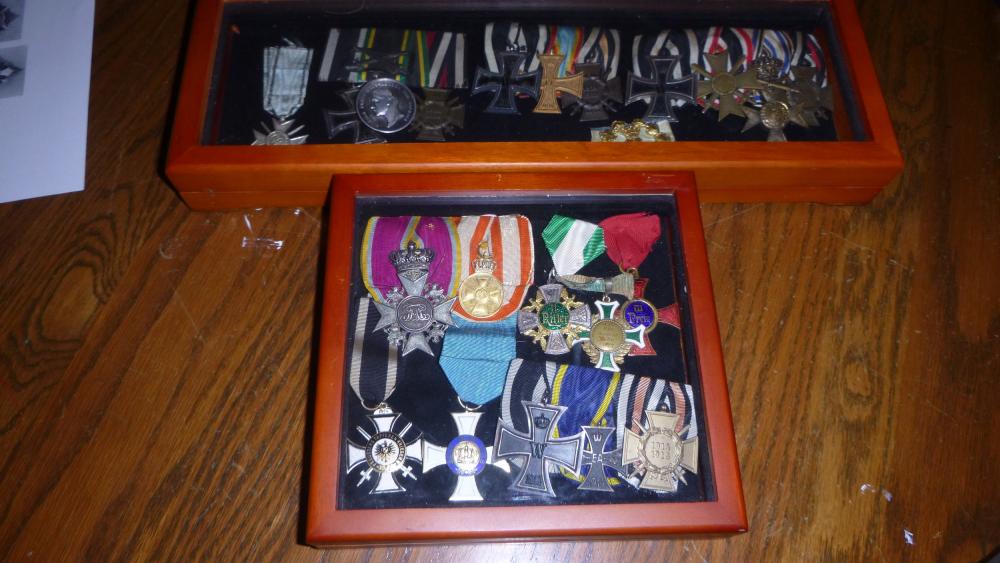

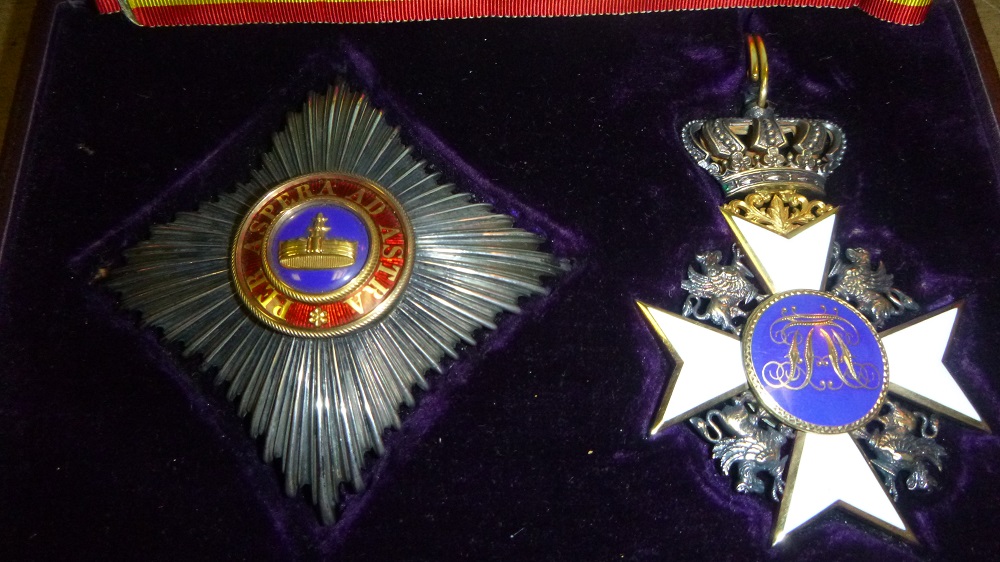
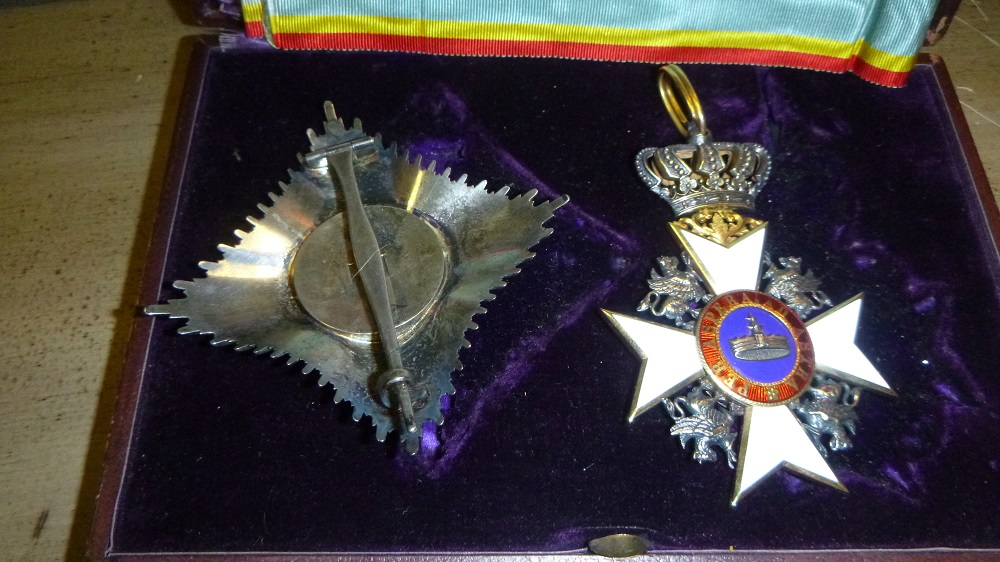
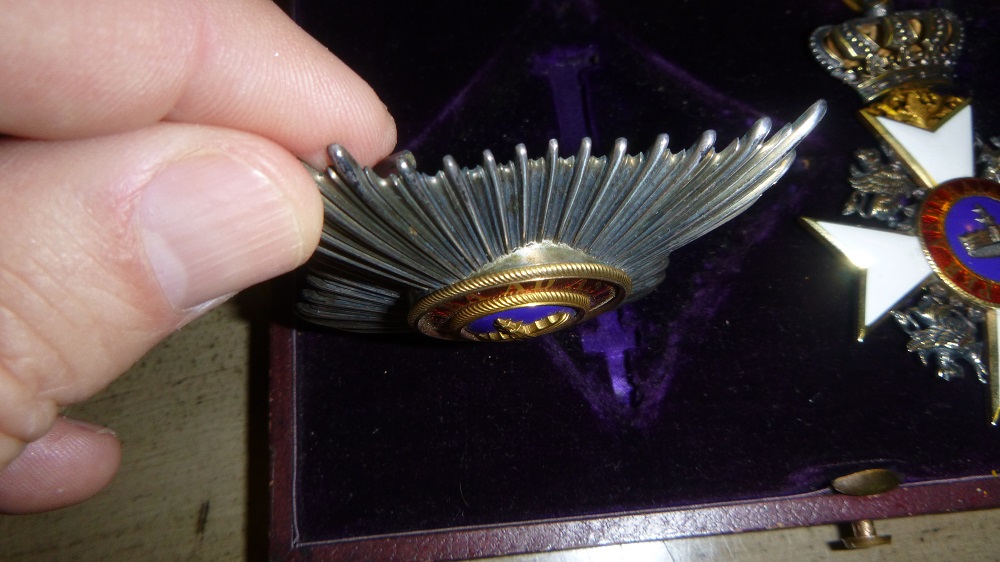
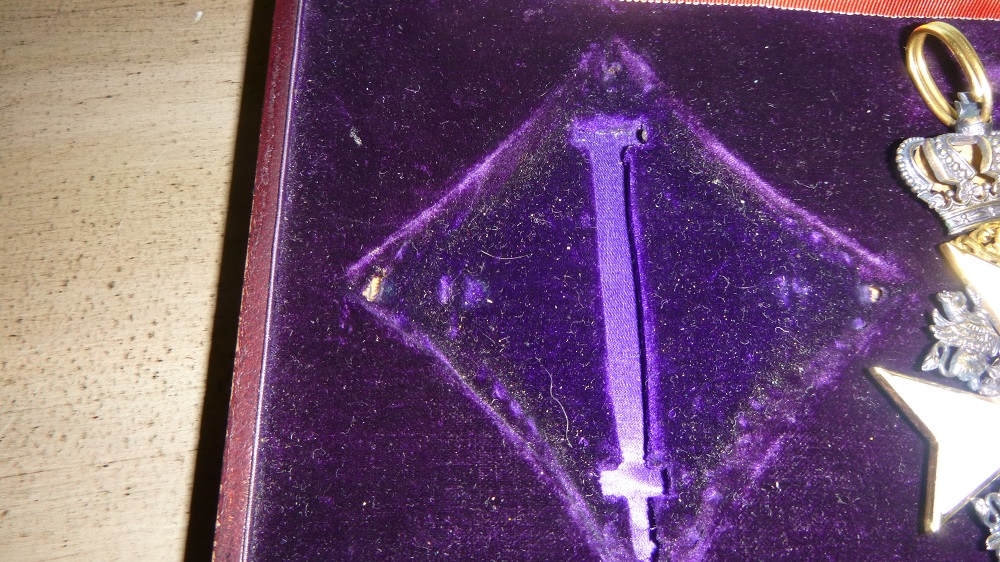
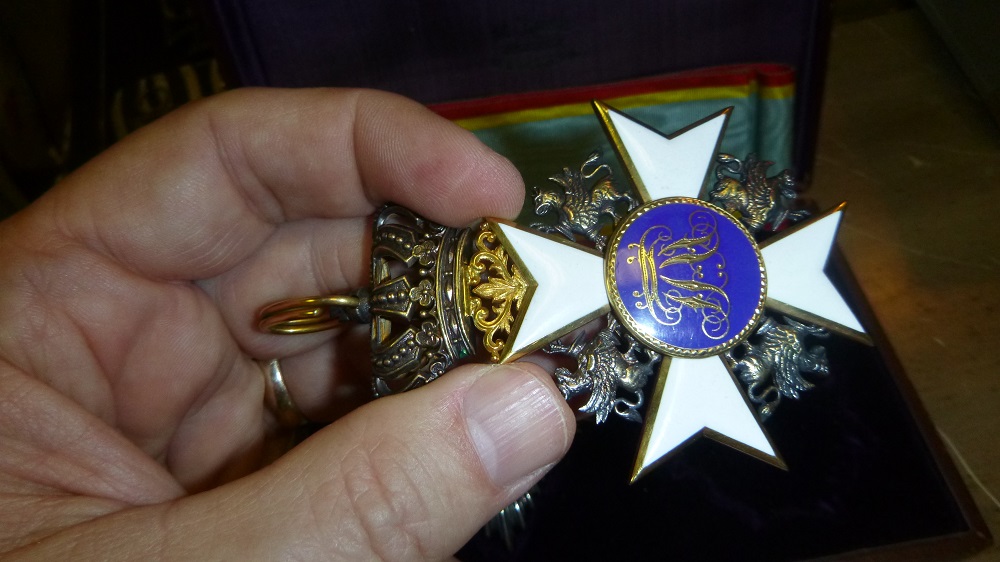
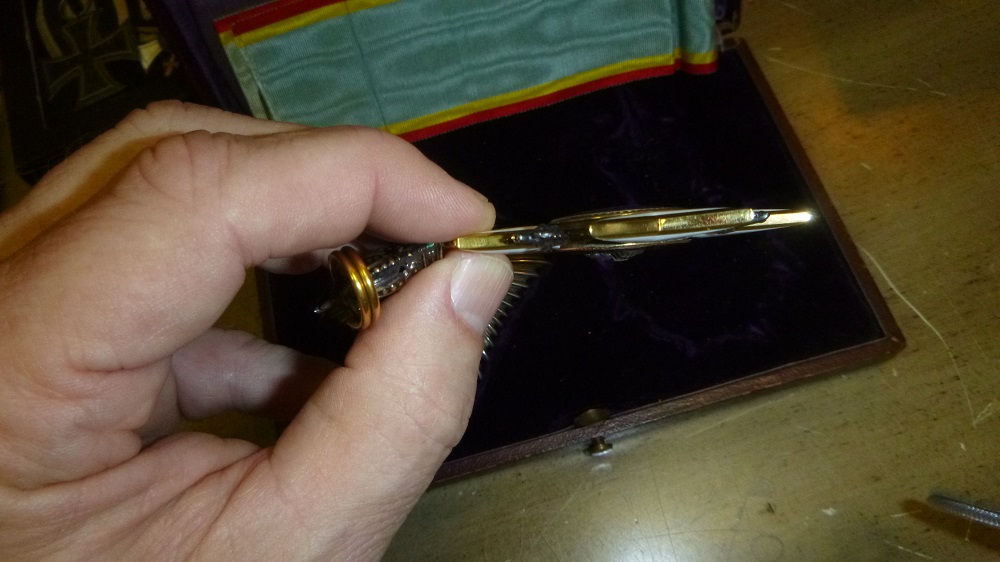
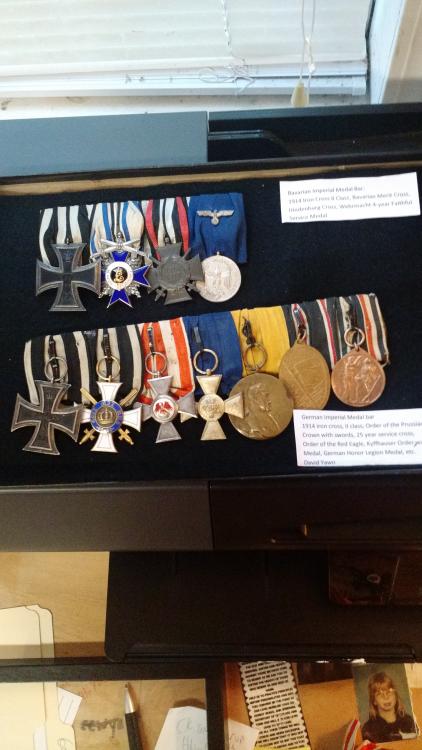
.thumb.jpg.c4afcc3ece7c5157fac18fd75b8ec58e.jpg)
